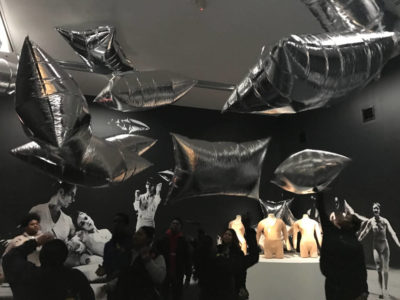DATE
July 11, 2025
AUTHOR
Sean Hamilton
CATEGORIES
Teachers
SHARE
 As an art teacher, I am interested in spaces. Physical, historical, metaphysical spaces we inhabit, those we do not, and those we construct are all things that I try to consider in my teaching. Pushing into the cliché art teacher trope that I sometimes find myself aligned to, I proposed to my students the idea of a local museum guerilla performance. The eventual concept was that during our visit to such a space as a prestigious art museum, my students would, in unison, scream at the top of their lungs for but a second. They were thrilled at the final concept and were all excited to participate.
As an art teacher, I am interested in spaces. Physical, historical, metaphysical spaces we inhabit, those we do not, and those we construct are all things that I try to consider in my teaching. Pushing into the cliché art teacher trope that I sometimes find myself aligned to, I proposed to my students the idea of a local museum guerilla performance. The eventual concept was that during our visit to such a space as a prestigious art museum, my students would, in unison, scream at the top of their lungs for but a second. They were thrilled at the final concept and were all excited to participate.
Imagine a group of high school students standing in a cluster around some of the most iconic, expensive, culturally valuable art pieces in the western world. Screaming. Perhaps screaming in joy, delight, rebellion, pain, or perhaps out of the sheer discomfort of agreeing to such a task. Whatever was the story behind the scream was theirs to choose. It is performative in nature and has been done by artists and educators many times in the past. But this was something my students sought to claim and in the process would claim layers of critical dialogue related our unit concept of performative social norms. The stares, the looks, the murmurs, the security guards approaching were just some of the evidence that may not shift but merely would become amplified. The act of inhabiting a space on multiple planes of understanding, modality, and visibility warmed my art teacher heart. The act of inhabiting a space that was specifically not designed for my students of color could serve as both powerful and empowering. COVID prevented this performance.
As Claire said in the previous post, the message to our students is often that “you are meant to be kept silent and under control”. The image of the not-actualized museum performance consistently reappeared in my mind as activation of this message’s antithesis, something different:
“Be loud, be free, be you, be the center of attention, and know that you are still safe. You are doing nothing wrong but changing perspectives and spaces possibly for the better. Regardless, you have the power to do so and you own that power.”
While the performance did not come to fruition, I have seen the themes of this new message repeatedly brought up in student responses, discussions, artwork, affect, and even the culture of our classroom. I am not an expert on restorative practices, nor do I think I could ever define these practices with certainty. I also cannot claim to be an expert in teaching or transformation (whatever that means); some weeks there are more rough days than good. What I can speak to are how my mindsets shifted and evolved during my experience as an educator, how I think now, and more importantly, how awesome my students are.
This is Part 1 of a two part series created by Sean, one of our first RPIA educators. In his upcoming blog post, Sean will write about how he weaves restorative practices and student voice into virtual instruction.


